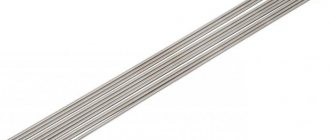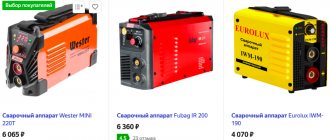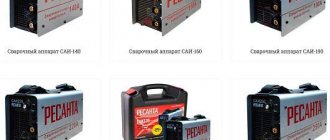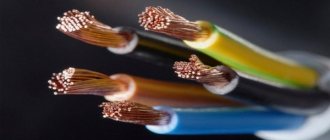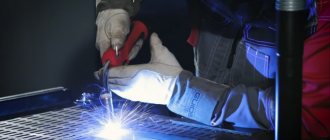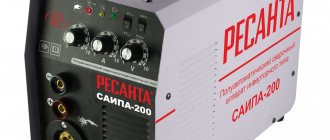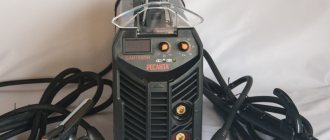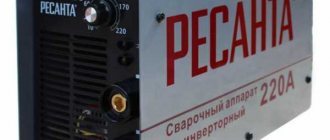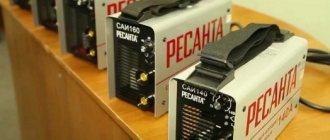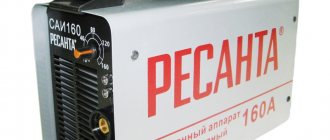What is the root of the problem?
It is necessary to warn that if you are determined to independently study the metalworking process, then you should pay special attention to the purchase of a welding machine. A qualified specialist can work without any problems with any device, with transformers that do not have a mode setting function, with inexpensive inverter models. A beginner in this business is recommended to purchase a modern model, which is more expensive in cost, but prevents the element from sticking.
If you don’t have the financial means to buy or you inherited an old modification, then study the reasons for sticking, which we described below.
Conclusion
Select the correct electrode diameter and current strength depending on the thickness of the metal being welded. Clean the surfaces to be joined. Observe storage and baking conditions. Use the “strike” method for ignition and maintain the optimal arc length.
Don't skimp when purchasing a welding machine. The ideal option would be equipment with additional functions “Hot start” and “AntiStick” . “Hot start” will provide an increase in welding current at the moment the arc is ignited, and “Anti-sticking” automatically reduces the current when sticking. But remember, an inverter with these functions will avoid most causes of sticking, but will not be able to completely eliminate it. Read about how to choose electrodes for welding here.
Electrode coatings: what are they?
To understand the problem of why the consumable sticks, you need to consider the types of electrode coatings. Most often on the market there are products with rutile and basic coatings. In practice, the difference in the use of these treatments is significant.
The base coating is used to create an even seam. Electrodes with a basic coating can guarantee the creation of a durable seam that will be resistant to corrosion and various loads. Even if the finished metal product needs to be operated at low temperatures, this will be possible with the creation of a seam using an electrode with a basic coating. Piercing is recommended before using the conductor. Don't forget to clean the metal base and remove dirt.
Rutile-coated conductors are often used by beginners because they are easy to weld. With their help, it is possible to create strong connections even on a contaminated base. If it is possible to clean the metal, do so, but even otherwise it will be possible to make a reliable connection.
Rutile consumables are designed for welding with direct or alternating current. The work produces little dirt, which is why they are popular in welding circles. When choosing the type of coating, it is important to determine the parameters of the future seam. For example, the characteristics include permissible tensile strength, ultimate fluidity, viscosity indicators and other parameters.
Why is there a lot of slag during welding?
When a lot of slag is formed during welding, they interfere with monitoring the quality of the seam being formed and performing the operation, since they conduct current poorly. The reasons for the appearance of large amounts of waste can be:
- Remains of dirt and rust on the edges. Large inclusions with tails are formed from them.
- Low value of metal deoxidation. Therefore, a lot of dissolved oxygen remains in the melt, which forms oxides.
- Welding with low-quality electrodes with a thin layer of coating. Due to uneven melting, their particles fall into the weld pool.
- Use of fluxes with refractory components. Due to their high specific gravity, their oxides do not rise to the surface.
- Process disruptions. If the angle of inclination is incorrect or the electrode moves quickly, the parts do not have time to warm up and quickly cool down.
Main causes of sticking
First of all, you should pay attention to the welding inverter. If it is of low power, it will not be able to produce enough current to weld thick parts. There are many other reasons why the electrode sticks during welding, these include:
- raw electrodes;
- chipped coating or its low quality;
- the core material is not suitable for the metal being welded;
- large voltage drops in the network can lead to low welding current or its sharp surges;
- a welder with low qualifications, for fear of burning a hole, sets a very low current on the welding machine;
- failure of device or inverter settings;
- When connecting, the phases are reversed, welding is carried out with a current of reverse polarity. This rule does not apply when welding aluminum and its alloys;
- the integrity of the welding cable may be compromised;
- pay attention to the heating of the welding holder, at a very high temperature, it is necessary to connect it to the cable;
- poor quality of preparatory work, parts are not cleaned of grease or rust;
- the possible reason is the low qualification of the welder and the inability to maintain a normal level of electrode combustion;
- The reason may be that the electrode is heavily soiled.
As you can see, the electrodes stick either due to non-compliance with the technology, or due to some defects in them themselves.
Raw electrodes
The welding electrode consists of a steel core and powder coating. The coating material is quite hygroscopic and, when stored in high humidity conditions, absorbs water vapor from the air.
If stored for a long time, even in a moderately humid room, the coating may also become damp.
If the electrodes were sealed in vacuum plastic packaging at the manufacturer's factory, they will not be exposed to moisture. But if the film is even slightly torn during transportation, the electrodes will inevitably become damp.
The damp coating begins to conduct electric current, as a result the arc does not ignite, and the electrode sticks to the workpiece.
Low quality
Why does the electrode stick if it is dry? It may not be of sufficient quality. Welding materials purchased in random places or from hand are often manufactured in violation of technology, the material of the rod does not meet the requirements of the standards, and the coating does not adhere well to the core and crumbles. In this case, sticking will also be frequent. It happens that the rod material is not suitable for the alloys being welded. Incorrect selection of consumables leads to constant attenuation of the arc or even the impossibility of igniting it .
Experienced welders check the quality of suspicious materials this way: they drop a rod from a height of 1.5 meters onto a flat concrete floor. If the coating has crumbled or peeled off, it is clearly not worth using such products.
In searching for the cause of electrode sticking, you can go through all the options. But quite often welders are faced with basic low-quality consumables. Even if you set the welding mode correctly and comply with all storage conditions, low-quality electrodes will stick. This cannot be corrected, so when choosing consumables, pay due attention to the choice of manufacturer.
The market may offer counterfeits under brand names. The only way to prevent the purchase of such electrodes is to check the documentation. If you are purchasing products to create strong seams in structures for which you are responsible for the integrity and safety, be sure to check compliance with GOST.
To make sure that there is lubricant on the tip, you can throw the electrode flat from a height of about 2 meters. If a chip in the coating is visible, this indicates low quality. Such electrodes should not be used when welding with an inverter.
Damp electrodes are another obstacle to creating a strong seam. High humidity compromises the stability of the connection. Since the arc is short, you will have to press the conductor against the metal base. Consequently, electrode sticking will occur. And over time, cracks form on the surface of the seam.
Effect of current
Novice welders are often afraid of burning through the workpiece, especially if it is small in thickness. Therefore, they underestimate the welding current values found in the tables, mistakenly thinking that with a low current they will slowly weld everything without defects. Unfortunately, this approach doesn't work.
If the current is insufficient, the melting of the workpiece and core to the metal stops before it has even begun, since the current strength is not enough to maintain the arc. The tip of the rod is immersed in the unformed and rapidly cooling weld pool and is seasoned with it.
It is necessary to set the current strength according to the tables and learn how to properly ignite an arc and make a seam.
Incorrect machine settings
This is also a fairly common cause of sticking during arc striking. At the beginning of the welding process, you need to accurately estimate the thickness of the metal that will be welded, select the appropriate diameter of the consumable and set a certain power.
The low current does not ignite the arc, but only slightly melts the tip of the rod, which sticks to the surface.
Mains influence
Why else might the electrode stick? The stability of the electrical network parameters has a strong influence on the ignition and maintenance of the electric arc.
This happens especially often when using outdated models of welding machines - AC transformers and rectifiers. The voltage on the secondary winding of the transformer in such units directly depends on the voltage in the network. If the voltage is unstable, then its surges also lead to the inability to ignite the arc; the secondary voltage is not enough for the discharge.
If the power of the local network is insufficient, then the very switching on of the welding transformer causes sudden voltage drops in the network, and the newly ignited arc dies out, and the tip of the electrode sticks to the cooling weld pool. This happens especially often when there is a lack of practical experience.
The use of welding inverters allows you to get rid of this dependence.
Lack of experience
Why does a dry electrode stick when welding with an inverter? In addition to underestimating the current, there is another typical mistake of novice welders. This is an attempt to keep the electrode too close to the workpiece . An air gap that is too short leads to a breakdown in the arc, the beginner tries to save the matter by bringing the tip even closer - and sticks it into the weld pool, where it can stick.
Errors occur both in the trajectory of the electrode during ignition and in guiding it along the seam. With a lack of experience and an attempt to use professional electrodes, such as UOSI, they also stick, most often due to excess welding current
It is necessary to get better at training preparations; once you gain enough experience, this effect ceases to appear. It is better to train on simple structural steels, and only then switch to alloy or stainless steel. Training should be conducted on inverter welding machines.
Uncleaned metal and improper arc ignition
The contaminated surface of the parts does not facilitate proper contact of the mass holder with it, and indeed the electrode itself. When you try to light an arc, it may go out and the coating may begin to fall off. Further actions will lead to sticking of the tip of the rod. Often, in the absence of experience, sticking occurs due to improper ignition of the arc. By tapping the tip of the rod on the workpiece, the electrode lingers on the surface for too long. A short circuit occurs, the metal at this point quickly heats up and solders the rod to the surface.
For novice welders, it is best to learn how to ignite an arc not by tapping, but by striking the consumable rod on the surface.
These are the main causes of sticking during welding. How can they be avoided?
Damp electrodes
If the arc goes out and a short circuit occurs, inspect the surface of the element. During production, a metal or non-metallic rod is coated throughout the entire post with a special coating in a thick or thin layer. Another option is welding wire, which is also the consumable part. The chemical composition of the mixture is different and each manufacturing company creates its own proportions for the content of carbon, silicon and phosphorus, since there are no strict regulations in this regard. If the composition is not particularly critical for the efficiency of use, then improper storage of the working element can lead to loss of quality characteristics and, as a consequence, sticking. Manufacturers pay special attention to packaging, using paper containers and polyethylene as additional protection against water penetration. The instructions say that if the integrity of the packaging material is damaged, it is necessary to use the consumables as soon as possible. Otherwise, the coating will be subject to accumulation of excess moisture.
The second reason for electrode sticking during electric welding (welding) is poor preparation of the workpiece surface
The plasma barrel immediately goes out after ignition due to the fact that the part has various contaminants: oxide film, rust, scale, bubbles, slag adhesion, chips, dust, etc. Before welding, the part must be cleaned with a rotating wire brush, scraped using a grinder and degreased with a special liquid. An inexperienced master, rushing to complete the work on time, does not pay attention to this and, in fact, loses productivity, since he cannot ignite the arc.
Incorrect device settings for welding parts
For proper melting, it is necessary to select the current mode. If the feed is insufficient, the tip of the rod melts and it partially sticks to the workpiece. If there is excess current, the consumable is simply destroyed.
Another reason why the electrode sticks (sticks) during electric welding is the discrepancy between the thickness of the material and the diameter of the working element.
We provide you with a table with approximate parameters that should be installed on the equipment depending on the intended task.
| Electric Flow Power | Diameter of the consumable in millimeters | Metal alloy thickness(mm) |
| 25-50 | 1-2 | 1,6 |
| 40-80 | 2-3 | |
| 60-100 | 2-3 | 2,5 |
| 80-160 | 3-4 | 3-4 |
| 80-160 | 3-4 | 4-5 |
It is worth noting that a special influence is exerted mainly by excess or insufficient current strength. If you set up your equipment correctly, the welding quality will not change when melting metal workpieces of any parameters.
The reasons why the electrode sticks when welding with an inverter are poor consumables
It is surprising what is wrong if the coating of the rod is dry. The problem lies in the low quality of the product. This can only happen in one case – if the products were manufactured in violation of the production technology. Factories must have a quality control department, the scope of which includes independent compliance control, which is a guarantor of the quality of products offered to the consumer. The fact of acceptance must be reflected in the relevant documents: certificate, instructions for use, technical data sheet, label, etc.
Low-quality consumables are most likely produced by handicraft methods in underground workshops or garages. Non-certified products have a low cost, but do not guarantee business success. Therefore, you should not immediately purchase products; check one copy in this way: lift the rod above your head and throw it with a flourish onto a hard surface (concrete, asphalt). If the coating crumbles, it is better to refuse the purchase.
Incorrect arc ignition
A beginner in this process has no experience, so he does not know that the operation can be performed in two ways:
- The working element is brought vertically closer to the plane of the part and, after touching, it is very quickly moved upward to a certain distance along the length of the column.
- They scratch “casually” from the surface of the material.
The most common one can be seen when an inexperienced master taps for a long time and at the same time leaves the tip of the rod on the surface being welded for a long time. Because of this, excessive heating of the workpiece occurs, leading to sticking.
Effect of electric current
We have provided you with a table above from which you can calculate the work. Due to the fear of damage to the workpiece by burning or allowing defects (insufficient or redundant weld layer, interruption of geometry), the young specialist does not adhere to the permissible parameters, but reduces the power of the device. This leads to the fact that the matter ends before it has even begun, since the current strength is absolutely insufficient for stable contact with the surface. If you have little experience, then use the method of gradually increasing power as needed, this way you will select the right mode. Just conduct an experiment on a defective part that you don’t mind throwing away after the trial work.
How does the power supply affect
Old devices are especially sensitive to unstable parameters, since the voltage on the secondary winding of the transformer directly depends on the power of the power station. If there is insufficient heat, the mechanism in the unit jumps, which leads to the impossibility of igniting the arc, since the voltage is not enough to create a discharge. And if it is possible to perform this action, then the newly ignited plasma barrel will most likely go out, and the tip of the rod will stick to the cooling bath. Unfortunately, the stability of the power supply depends on many factors. This is the terrible quality of power lines, and the further you are from big cities and transformer substations, the worse the situation with electricity is. In addition, voltage can change due to weather conditions, time of day and even seasonality. For high-power devices such as welding machines, poor electrical supplies have a particularly negative impact on their efficiency. During surges, instead of a stable arc, the specialist receives only the flickering of weak sparks, and the transformer emits a loud hum in short circuit mode. Even the use of thin electrodes does not save the situation. As a result, when a powerful load is turned on, a sharp decrease in voltage occurs in the local network, which ultimately can negatively affect the operation of household appliances, even to the point of failure. This is fraught not only with failure to complete the assigned task, but also with conflict situations with neighbors.
Troubleshooting
Let's add a few words about how to diagnose malfunctions in the device.
If you smell burning or smoke from the inverter housing, this is a signal of a very serious breakdown. We do not recommend diagnosing the device yourself in such a situation; it is better to take it to a service center. Eliminating such malfunctions requires many years of experience and understanding of all the nuances of the operation of the device.
If the breakdowns are less critical, you can do the diagnostics yourself. To do this, remove the housing and visually inspect all components of the device. Sometimes manufacturers produce models with poor-quality soldering or low-quality wires. In such cases, you can simply re-solder individual sections and the device will work properly.
Improper storage and why the electrode sticks when welding
Every welder must follow the rules for storing electrodes. They are designated by the manufacturer on the packaging. The main requirements are temperature and humidity. As for large suppliers, they most often fulfill these requirements
Home-made sellers do not focus much attention on this, so the electrodes may become unusable when they are already on sale.
Electrodes must be available for use in accordance with their expiration date. Otherwise, the surface lubricant will crumble. Most often, the tip, which is responsible for the quality of welding, suffers. Such electrodes will definitely stick
It is important to know that after opening the package, after 8-10 hours, it is recommended to additionally dry the consumable. This will reduce the risks of the negative effects of high humidity
When drying, the moisture evaporates and the electrodes restore their properties.
How to eliminate electrode sticking
Eliminating the sticking phenomenon is quite simple. To do this, you need to use high-quality consumables, set the desired mode and prepare the parts before welding. And, of course, you will need a little experience in lighting an arc.
Preparing materials
Items that were stored in a dry room with a good ventilation system do not need further processing, especially if the batch was taken in original packaging. If moisture gets on the surface, thorough drying is necessary.
Let's talk about the methods used at home if the kit becomes damp.
We offer “folk” remedies for heat treatment:
- Using an electric oven - a gas oven will not work, since heating is not recommended over an open fire. To do this, you need to raise the temperature to 200 degrees, place a bunch of rods inside the equipment, fry for 2 hours and leave there until it cools completely.
- Warming up with a construction hairdryer, where on models there is functionality for setting the temperature regime. Select a container whose diameter is comparable to the hole of the tool. Electrodes are placed there and then hot air is directed at them.
- Building a furnace takes more time, but for people who plan to work with welding on an ongoing basis, this provides a guarantee of effectiveness. We will not touch upon the construction process, since deciphering this topic will require writing a new article.
The above methods are quite suitable for electric welding of non-critical components. However, if a specialist wants to improve his skills and has the financial ability to achieve excellent results, we recommend purchasing special professional equipment, such as a thermal pencil case or a muffle furnace.
Let's start setting up the equipment
The effectiveness of the event will depend on how you can correlate the thickness of the welded material, the diameter of the electrode and the current power.
All these parameters are displayed in the table of the device’s technical passport. It is worth studying them carefully, but at the same time understanding that these are basic data and deviations from the norm are quite acceptable, provided that the specialist has extensive experience and keeps the device in perfect order. Each raw material has its own current parameters, for example, for plates 3 mm thick it is necessary to set 100/120 A. Not all devices are equipped with an adjustable transformer. For those using older models, it is important to move the cable connection to the level where the current stops burning through the weld point. It is important to know! To avoid burn-through (the formation of holes) on a structure made of thin-walled material or when working with car bodies, you should gain experience. To do this, take an unnecessary part and start welding, where by trial and error you will select the required power mode of the device, gradually increasing the current.
In addition, before starting work, it is worth checking the voltage in the network with a special tester. Once you make sure that the line is not overloaded, you can begin to implement the plan. Otherwise, you should wait until the problem stabilizes. If jumps are repeated time after time, then purchase a stabilizer; it will help you carry out the task uninterruptedly and calmly.
The correct combination of ground cable and holder is of no small importance:
- Sixteen-core copper wire with an outer diameter of 11.5 millimeters is suitable for thin-wall material.
- For welding a thicker sample, a 25-core cable with a 13.5 mm hole is suitable.
Learning how to properly create a plasma barrel
If you are new to the business, then we offer you a simple method, once mastered it will be easy for you to move on to the professional ignition method.
To do this, move the electrode like a match across a box, you will get a striking sound. In this case, try to keep the working element perpendicular to the workpiece. After the arc has flared up, you should tilt the consumable back at an angle of 15 degrees and quickly move the seam along the intended line. The main condition is continuity in work, since stopping even for a short time threatens combustion failure.
Modern devices have high-frequency ignition, which allows the formation of a plasma barrel without directly touching the material. That is, when the consumable approaches, an arc is created due to high-frequency currents, which is accompanied by a buzzing crackling sound.
We provide you with a visual aid, after looking at which you will understand why electrodes stick when welding on an inverter and what needs to be done to prevent this:
How to prevent electrode sticking
Now that we have found out why the electrode sticks when welding with an inverter, we will talk about simple methods for preventing errors. What can every welder do to prevent the electrode from sticking? The solution is not difficult to find based on the essence of the problem.
Solution #1: Prepare the electrodes and metal
Buy electrodes in sealed packaging from trusted manufacturers. These can be domestic Rotex rods or European ESAB rods. They meet quality standards and should not stick if you set up the device correctly and ignite the arc.
If the electrodes have been left unpacked for more than 8 hours, they need to be dried. This can be done in an electric furnace, taking into account the melting temperature of the electrode. The electrode itself cannot be dried more than three times, otherwise it will lose its properties.
Also, do not forget about preparing the metal. Thoroughly clean the surface of the parts from dirt, rust and paint.
Solution #2: Configure your hardware correctly
By setting the correct settings for the welding inverter, you will not only prevent sticking of the electrode, but also improve the quality of the weld. Below you can find the recommended settings that you should set on your device.
But keep in mind that these are approximate values and you need to rely not only on educational tables, but also gain your own experience. We recommend that all beginners start with a low current setting and increase it gradually. Over time, you will begin to understand what parameters are needed in each individual case.
Solution #3: Learn how to strike the arc correctly
To light an arc, many welders use the method of tapping the tip of the electrode on the metal, but we recommend not tapping, but striking (similar to matches).
First, “idle”, practice moving the end of the electrode smoothly along the surface of the metal. Once you can do this quickly, you can start lighting the arc.
After igniting the arc, it is necessary to ensure that it is of sufficient length. It is important to learn how to do this quickly, otherwise the electrodes will stick and ruin the whole job.
How to prevent electrode sticking
So, we should summarize and highlight the main points so as not to encounter such a problem as sticking of the electrode during welding.
What we finally have:
- Electrodes must be suitable for welding with an inverter, selected in accordance with the thickness of the metal being welded and absolutely dry;
- The welding current on the inverter must be set in accordance with the diameter of the electrodes used for welding;
- The surface of the metal being welded should not be dirty or rusty;
- The voltage in the electrical network (which was not mentioned above) should be normal. Often, a voltage deviation downwards leads to the fact that the inverter simply does not draw or produce the required current parameters;
- In the process of welding metals, it is extremely important to eliminate errors such as incorrect ignition or an arc that is too short.
All of the above tips should help novice electric welders in their difficult task.
Content
- Reasons for electrode sticking when welding with an inverter:
- 1. Damp electrodes
- 2. Wrong choice of electrode
- 3. Poor quality electrodes
- 4. Low welding current
- 5. Wrong way to ignite the arc
- 6. Short arc
- 7. Poorly cleaned metal surface
- Tips to prevent the welding electrode from sticking to the metal:
- 1. Choose appropriate settings
- 2. Keep the electrode and surface clean
- 3. Follow proper arc striking technique
- 4. Use the appropriate arc length
- 5. Store electrodes in a dry place
- Conclusion
Which electrodes to use to avoid sticking
If you want to avoid sticking of the electrode when welding with an inverter, consider the basic recommendations of experts. The main rule is that the electrodes must be designed to work with direct current.
If you don't want the electrode to stick, don't skimp on consumables. Choose trusted manufacturers whose products you have already tested. Electricals must comply with GOST or other international standards, demonstrating high quality and durability.
If you want to learn how to properly use an inverter welder, learn how to start and hold the arc. The theoretical basis will help you avoid common mistakes that lead to the creation of an unsightly seam of the wrong diameter.
Rating of electrodes for inverter
Electrode ratings are published constantly; they can differ significantly from each other in different sources.
Without pretending to be objective, the “arithmetic average” rating is as follows:
- rutile-cellulose consumables from the famous Swedish company ESAB ;
- American Omnia 46 from Lincoln Electric;
- Russian OZS-12 ;
- Russian electrodes Resanta MR-3;
- UONI–13/55;
- ANO : the most popular in Russia.
Features of the use of welding equipment and electrodes for electric arc welding
As is known, a welding inverter is a direct current device for welding metals of different thicknesses and qualities using a fusible electrode with a steel core and a special coating as a working element.
For work with the inverter, electrodes are used that are classified as “universal” and intended only for working with direct current. The use of electrodes that have a specification for working with devices that produce only alternating current leads to unstable ignition of the arc, the arc does not work stably, and great effort is felt to hold both the arc itself and the weld itself. Most often, in this case, the electrode simply does not have time to warm up, the metal forms a large drop and then the unheated electrode tightly sticks to the surface to be welded.
To solve this problem, if it has already arisen, is quite simple, you need to replace the electrode with one that is intended for welding with direct current. This is the most effective and reliable method, neither increasing the current power nor changing the polarity will help at all, the result will be predictable, the adhesion of large drops, an unstable seam, sticking of the electrode and a high probability of failure of the welding machine itself, especially when working with a large diameter electrodes.
Selecting an inverter device
To understand why the electrode sticks when welding with an inverter, you must first make the right choice of welding machine in relation to the conditions of specific work. The unit must meet certain requirements that will ensure optimal operation of the device in real circumstances. An example of such a device created for Russian conditions is the inverters of the “Neon” line produced in Nizhny Novgorod. Based on these devices, we will talk about the basic requirements for welding machines, which will reduce the likelihood of electrodes sticking during welding. These properties are as follows:
- the mains supply voltage ranges from 160 V to 250 V, which makes it possible to work in conditions of unstable power supply;
- the presence of an automatic protection switch, including overheating;
- PV at maximum welding current 60%;
- open circuit voltage 70 V, which allows you to confidently hold the arc even at extreme input voltages;
- there is a hot start function for reliable ignition of a short circuit arc, as well as arc afterburner;
- To prevent the electrode from sticking, there is an anti-stick function;
- guaranteed stable operation at ambient temperatures from -40 °C to +40 °C.
It should be noted that these characteristics serve as a basis for selection, and not as a dogma, but stable operation at extreme temperatures and network voltages is very important for Russian conditions. For comfortable work, it is useful to use the hot start function, which helps to confidently start the process and optimally use welding electrodes for inverters.
Particular attention should be paid to such functions as anti-stick or anti-stick. Its essence is that at the moment of sticking, the welding current is reset to zero and this allows both the electrode itself and the inverter to be kept intact. Afterburner also helps eliminate sticking, allowing you to increase the welding current at the risk of arc breakage and prevents interruption of the weld, which has a beneficial effect on the quality of work.
When choosing an inverter device, it is important to pay more attention to Russian models, since they are repairable and better adapted to work in the conditions of our country.
Recommendations
One of the easiest ways to overcome this problem is the additional “anti-stick electrode” function, which is available on modern welding machines. Naturally, it will not help in the most difficult cases, but it will make their use much simpler and easier.
You also need to pay attention to the correct selection of the electrodes themselves and the modes of their use. This is the main way to avoid sticking. After all, sometimes it is enough just to raise the current to the required level and the arc will stabilize.
Before using consumables, they should be dried and calcined to remove moisture. Even if these are new consumables, these procedures should be carried out, since during transportation and storage they could absorb liquid from the air.
It is necessary to check the end of the electrode, both during the first ignition and during subsequent ignitions. Since at the very beginning the coating may crumble. And then slag may stick to the end, which will interfere with welding.
Recommendations for DIY repairs
When repairing inverter-type welding machines, you should adhere to a certain algorithm:
- If a malfunction occurs, you must immediately disconnect the electrical device from the network, allow it to cool, and only then open the metal casing.
- Diagnostics must begin with a visual inspection of the electrical components of the inverter. There are often cases when repairing an inverter welding machine involves simply replacing damaged parts or soldering conductive contacts. Visually enlarged capacitors or cracked transistors should be replaced first.
- If a visual inspection fails to determine the cause of the malfunction of the welding machine, you must proceed to checking the parameters of the parts using a multimeter, voltmeter and oscilloscope. The most common failures of power units are associated with malfunction of transistors.
- After replacing the electrical elements, it is worth moving on to checking the printed conductors located on the inverter board. If you find torn or damaged tracks on the printed circuit board of a welding tool, you must immediately eliminate the defect by soldering jumpers or restoring the tracks using copper wire of the required cross-section.
- After completing work with the tracks, it makes sense to move on to servicing the connectors. If the inverter device stopped working gradually, then there may be poor contact in the connecting connectors. In this case, it is enough to measure all contacts with a multimeter and clean the connectors with an ordinary household eraser.
- Despite the fact that malfunctions of a welding inverter are rarely associated with diode bridges, it would be a good idea to check their performance. It is better to diagnose this electrical element in a soldered state. If all the legs of the bridge are short-circuited, then you should search for the faulty diode and replace it.
- The last step in inverter repair is checking the board and control panels. Diagnostics of all components of the board should be carried out using a high-resolution oscilloscope.
If the diagnostics have been carried out, but it was not possible to find out what is broken in the welding machine, you should stop doing independent repairs and contact specialized workshops.
When performing independent repair work, you should not forget about the safety rules:
- Do not use electrical appliances without a protective top casing;
- all diagnostic and repair work should be carried out on completely de-energized equipment;
- It is safest to remove accumulated dust and dirt using an air flow generated by a compressor or a compressed gas cylinder;
- Cleaning of printed circuit boards must be done using neutral solvents applied to a special brush;
- Long-term storage of electrical appliances should be done in dry rooms and completely switched off.
Most inverter electrical appliances are supplied complete with accompanying documentation. In these papers you can find a description of the most common faults and repair methods. Therefore, if malfunctions occur, you should carefully study the documentation and only then begin repair work.
Reasons for welding wires sticking
The problem with electrode sticking is typical when working with transformer equipment that does not have the ability to adjust the welding mode. It also often occurs among young, inexperienced specialists working with inverters.
What are the causes of sticking during welding? Here are the main errors and factors causing this problem.
The first reason is the increased humidity level of the welding rod. Its surface is treated with a special coating. This substance tends to accumulate moisture coming from the environment. Filler rods stored without packaging quickly become damp. This reduces their performance, leading to sticking during welding. The second reason is poor-quality electrodes
When working with a welding inverter, it is important to choose the right rods. Beginners who are inclined to save on consumables take electrodes from little-known companies without confirming the quality of the product
These filler wires are cost effective but can complicate welding tasks. Poor quality rods often stick during operation, negating their advantage. The third reason for sticking is incorrect equipment settings. Young professionals often ignore the preparatory stage of work. When starting welding, they do not clean or smooth the surface of the part. This breaks the contact of the welding rod with the metal surface. The welding arc in such a situation goes out immediately after starting work. To weld uncleaned parts that are unsuitable for work, you have to re-ignite it several times. As a result, the tip of the filler wire begins to stick to the joint. The fourth reason is improper ignition of the welding arc. The main factor in the emergence of this problem is the lack of experience of the employee. Incorrect ignition using the tapping technique, or holding the edge of the wire for a long time on the working surface of the part leads to overheating of the metal. The electrode is literally soldered to the seam, and this will not be corrected until the root cause is ruled out.
